Abstract
The response of tolerant Streptococcus sanguis and nontolerant Streptococcus mitis infections to penicillin therapy was compared in the rabbit model of endocarditis. The minimal inhibitory and bactericidal concentrations of penicillin were 0.1 and 0.1 μg/ml, respectively, for S. mitis and 0.05 and 6.2 μg/ml, respectively, for S. sanguis. Time-kill studies done in vitro with penicillin concentrations of 2 and 20 μg/ml demonstrated minimal killing of the tolerant strain, with a 3 log difference in survival between the two strains after 24 and 48 h. Both strains produced endocarditis with comparable bacterial densities on the valvular vegetations. Rabbits were treated with procaine penicillin G in two dosage regimens, 80,000 or 5,000 U/kg given every 8 h. There was no difference between bacterial densities in valvular vegetations removed from rabbits infected with either strain after 2, 4, or 6 days of treatment with the high-dose regimen (serum penicillin concentration at 0.5 h, 9.4 μg/ml), despite the fact that serum bactericidal activity against the tolerant strain at 0.5 h was minimal. With the low-dose penicillin regimen (serum concentration at 0.5 h, 2.5 μg/ml), therapy was significantly less effective in the tolerant group only after 6 days of treatment. Similar results were obtained when penicillin was administered in low and high doses to prevent infection. In this animal model of infection, penicillin tolerance was associated with a diminished response to penicillin therapy only when the dose was severely restricted. In the high-dose regimen, there was no difference in the response to penicillin therapy between animals infected with either strain, despite the presence of only minimal serum bactericidal activity in the rabbits infected with the tolerant strain.
Full text
PDF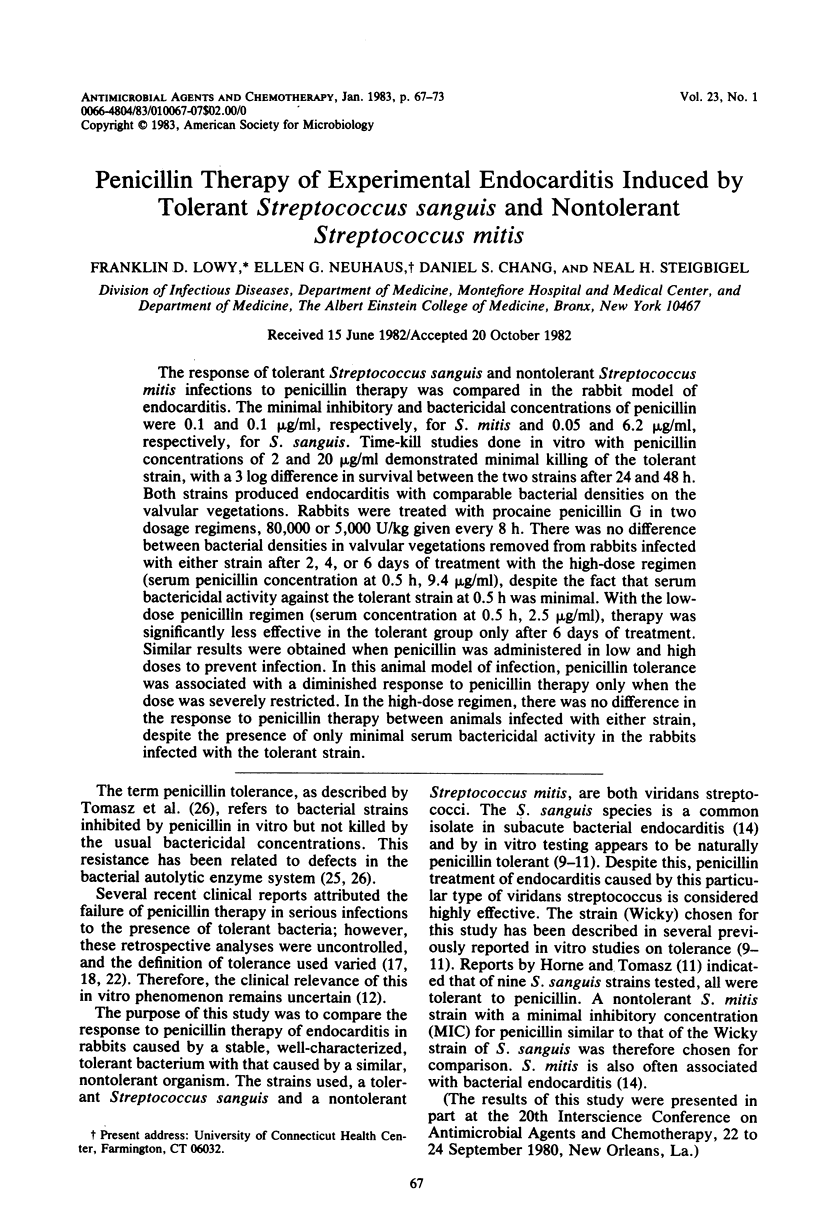
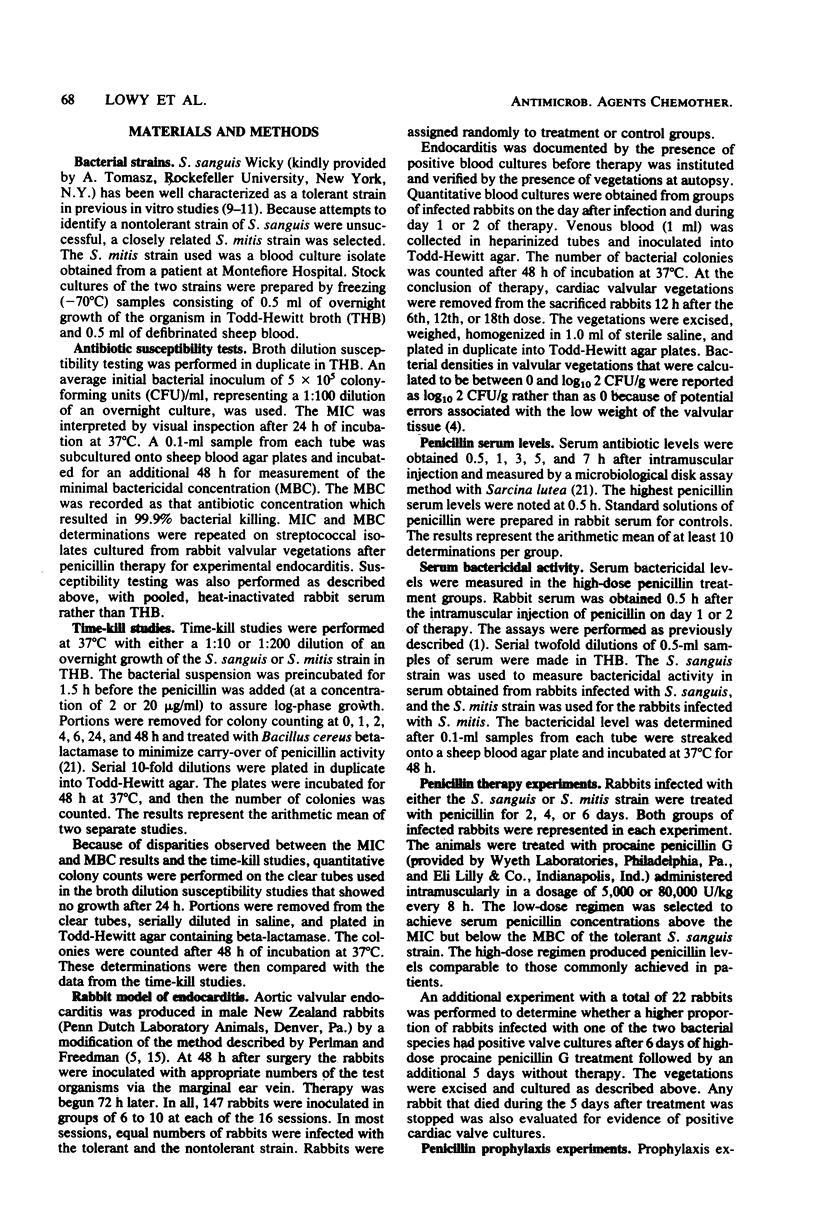
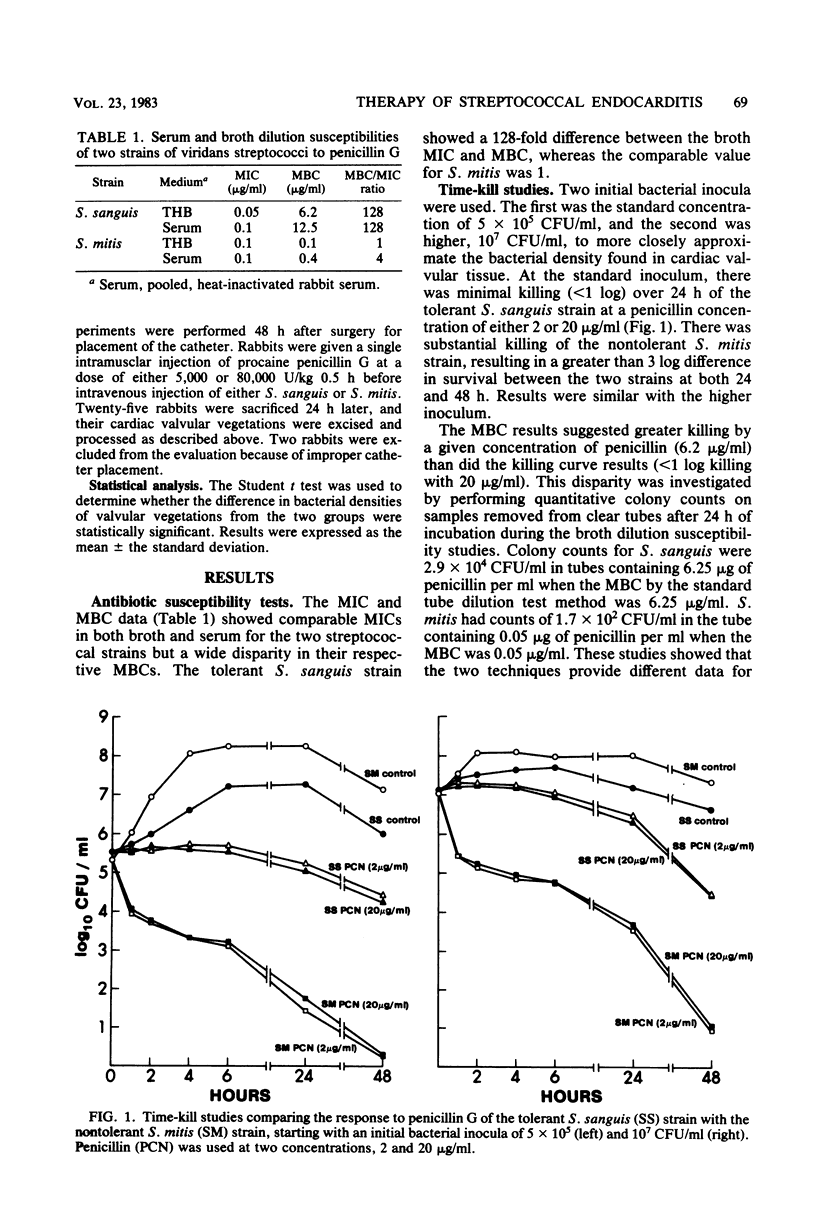
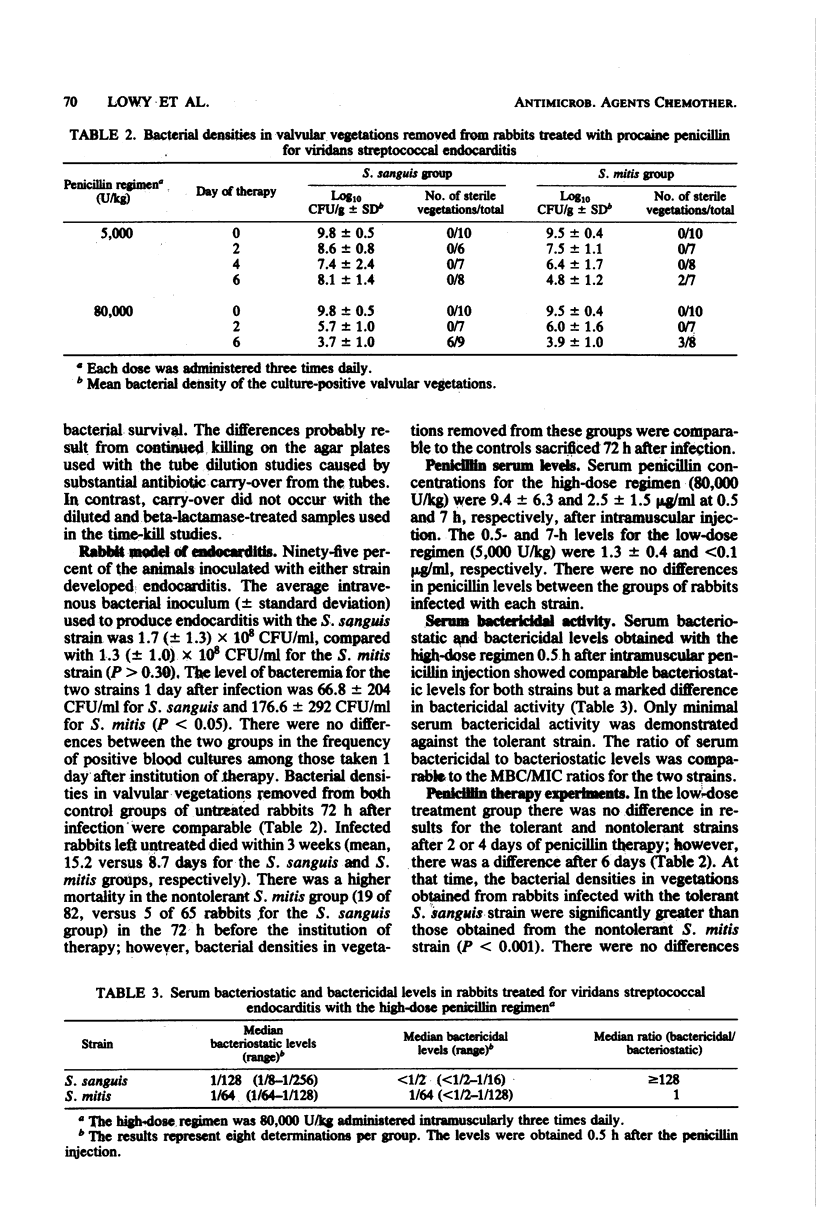
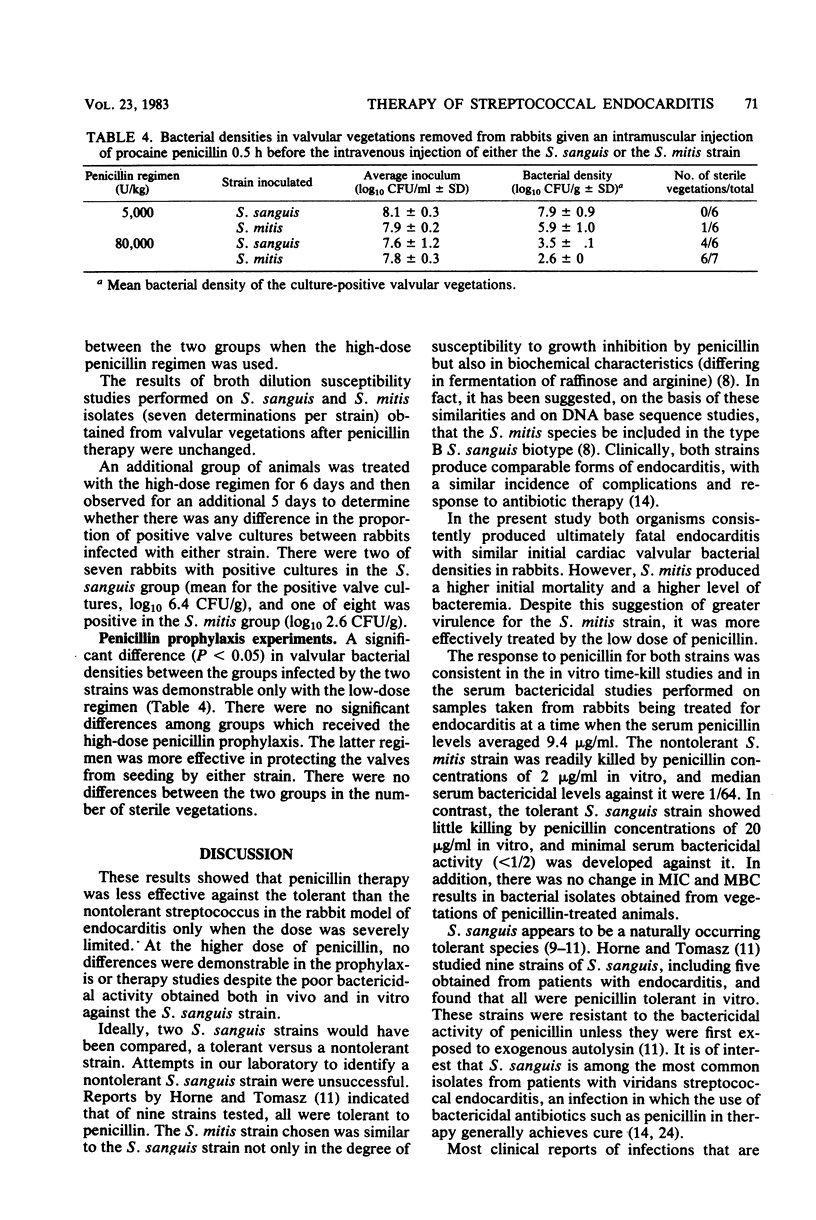
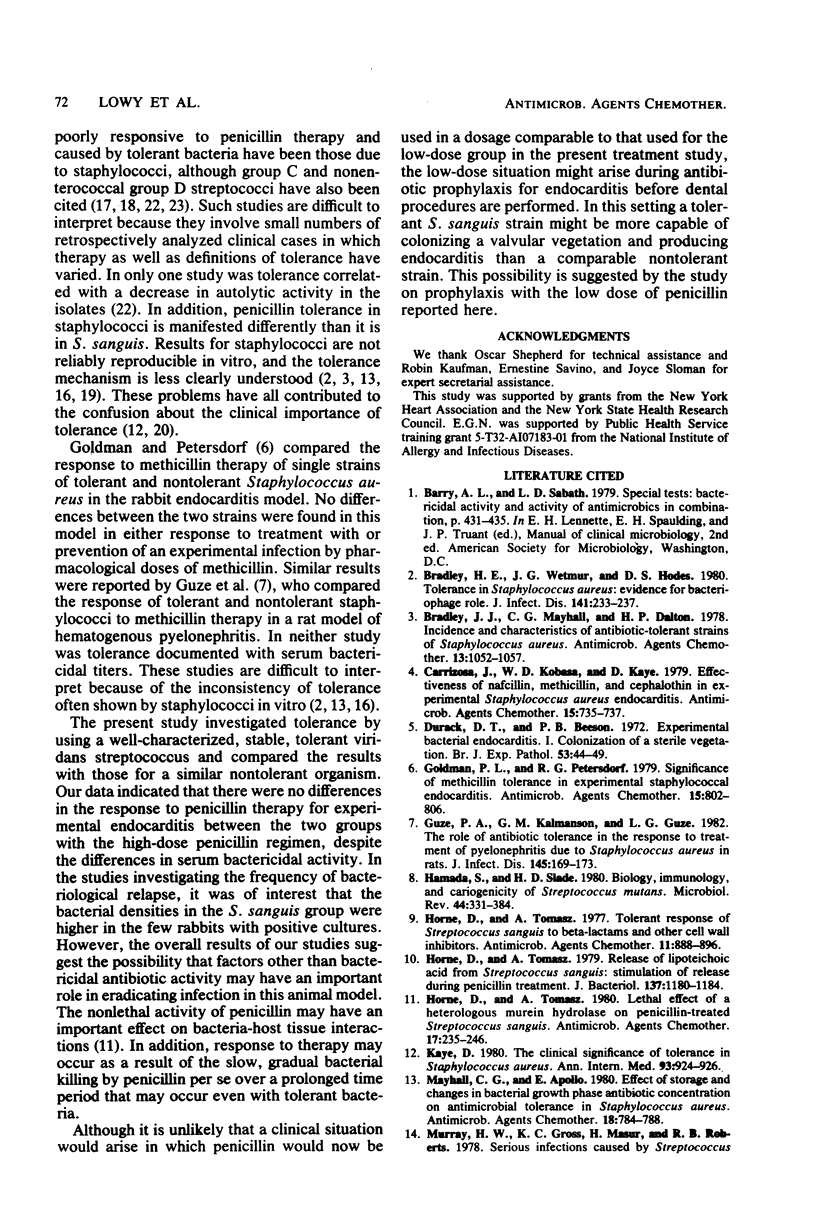
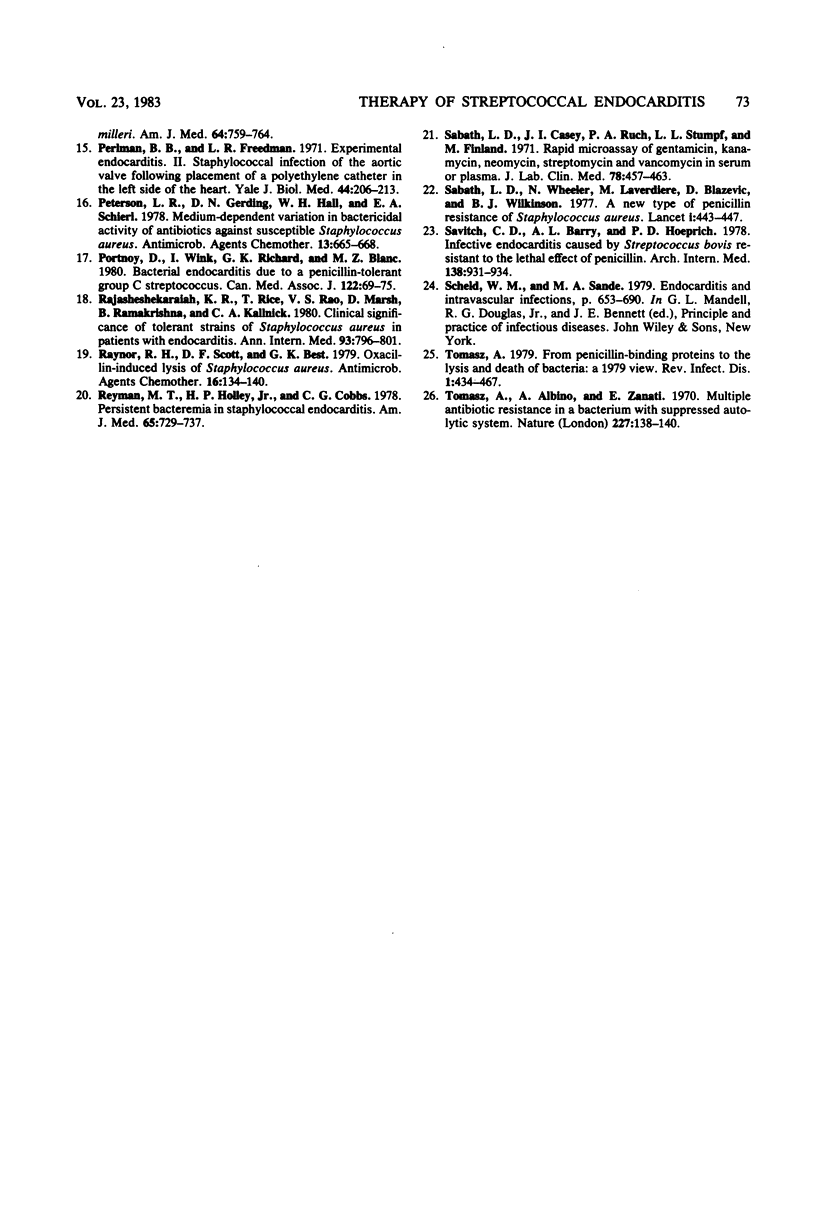
Selected References
These references are in PubMed. This may not be the complete list of references from this article.
- Bradely J. J., Mayhall C. G., Dalton H. P. Incidence and characteristics of antibiotic-tolerant strains of Staphylococcus aureus. Antimicrob Agents Chemother. 1978 Jun;13(6):1052–1057. doi: 10.1128/aac.13.6.1052. [DOI] [PMC free article] [PubMed] [Google Scholar]
- Bradley H. E., Wetmur J. G., Hodes D. S. Tolerance in Staphylococcus aureaus: evidence for bacteriophage role. J Infect Dis. 1980 Feb;141(2):233–237. doi: 10.1093/infdis/141.2.233. [DOI] [PubMed] [Google Scholar]
- Carrizosa J., Kobasa W. D., Kaye D. Effectiveness of nafcillin, methicillin, and cephalothin in experimental Staphylococcus aureus endocarditis. Antimicrob Agents Chemother. 1979 May;15(5):735–737. doi: 10.1128/aac.15.5.735. [DOI] [PMC free article] [PubMed] [Google Scholar]
- Durack D. T., Beeson P. B. Experimental bacterial endocarditis. I. Colonization of a sterile vegetation. Br J Exp Pathol. 1972 Feb;53(1):44–49. [PMC free article] [PubMed] [Google Scholar]
- Goldman P. L., Petersdorf R. G. Significance of methicillin tolerance in experimental staphylococcal endocarditis. Antimicrob Agents Chemother. 1979 Jun;15(6):802–806. doi: 10.1128/aac.15.6.802. [DOI] [PMC free article] [PubMed] [Google Scholar]
- Guze P. A., Kalmanson G. M., Guze L. B. The role of antibiotic tolerance in the response to treatment of pyelonephritis due to Staphylococcus aureus in rats. J Infect Dis. 1982 Feb;145(2):169–173. doi: 10.1093/infdis/145.2.169. [DOI] [PubMed] [Google Scholar]
- Hamada S., Slade H. D. Biology, immunology, and cariogenicity of Streptococcus mutans. Microbiol Rev. 1980 Jun;44(2):331–384. doi: 10.1128/mr.44.2.331-384.1980. [DOI] [PMC free article] [PubMed] [Google Scholar]
- Horne D., Tomasz A. Release of lipoteichoic acid from Streptococcus sanguis: stimulation of release during penicillin treatment. J Bacteriol. 1979 Mar;137(3):1180–1184. doi: 10.1128/jb.137.3.1180-1184.1979. [DOI] [PMC free article] [PubMed] [Google Scholar]
- Horne D., Tomasz A. Tolerant response of Streptococcus sanguis to beta-lactams and other cell wall inhibitors. Antimicrob Agents Chemother. 1977 May;11(5):888–896. doi: 10.1128/aac.11.5.888. [DOI] [PMC free article] [PubMed] [Google Scholar]
- Kaye D. The clinical significance of tolerance of Staphylococcus aureus. Ann Intern Med. 1980 Dec;93(6):924–926. doi: 10.7326/0003-4819-93-6-924. [DOI] [PubMed] [Google Scholar]
- Mayhall C. G., Apollo E. Effect of storage and changes in bacterial growth phase and antibiotic concentrations on antimicrobial tolerance in Staphylococcus aureus. Antimicrob Agents Chemother. 1980 Nov;18(5):784–788. doi: 10.1128/aac.18.5.784. [DOI] [PMC free article] [PubMed] [Google Scholar]
- Perlman B. B., Freedman L. R. Experimental endocarditis. II. Staphylococcal infection of the aortic valve following placement of a polyethylene catheter in the left side of the heart. Yale J Biol Med. 1971 Oct;44(2):206–213. [PMC free article] [PubMed] [Google Scholar]
- Peterson L. R., Gerding D. N., Hall W. H., Schierl E. A. Medium-dependent variation in bactericidal activity of antibiotics against susceptible Staphylococcus aureus. Antimicrob Agents Chemother. 1978 Apr;13(4):665–668. doi: 10.1128/aac.13.4.665. [DOI] [PMC free article] [PubMed] [Google Scholar]
- Portnoy D., Wink I., Richards G. K., Blanc M. Z. Bacterial endocarditis due to a penicillin-tolerant group C streptococcus. Can Med Assoc J. 1980 Jan 12;122(1):69-70, 75. [PMC free article] [PubMed] [Google Scholar]
- Rajashekaraiah K. R., Rice T., Rao V. S., Marsh D., Ramakrishna B., Kallick C. A. Clinical significance of tolerant strains of Staphylococcus aureus in patients with endocarditis. Ann Intern Med. 1980 Dec;93(6):796–801. doi: 10.7326/0003-4819-93-6-796. [DOI] [PubMed] [Google Scholar]
- Raynor R. H., Scott D. F., Best G. K. Oxacillin-induced lysis of Staphylococcus aureus. Antimicrob Agents Chemother. 1979 Aug;16(2):134–140. doi: 10.1128/aac.16.2.134. [DOI] [PMC free article] [PubMed] [Google Scholar]
- Reymann M. T., Holley H. P., Jr, Cobbs C. G. Persistent bacteremia in staphylococcal endocarditis. Am J Med. 1978 Nov;65(5):729–737. doi: 10.1016/0002-9343(78)90790-8. [DOI] [PubMed] [Google Scholar]
- Sabath L. D., Casey J. I., Ruch P. A., Stumpf L. L., Finland M. Rapid microassay of gentamicin, kanamycin, neomycin, streptomycin, and vancomycin in serum or plasma. J Lab Clin Med. 1971 Sep;78(3):457–463. [PubMed] [Google Scholar]
- Sabath L. D., Wheeler N., Laverdiere M., Blazevic D., Wilkinson B. J. A new type of penicillin resistance of Staphylococcus aureus. Lancet. 1977 Feb 26;1(8009):443–447. doi: 10.1016/s0140-6736(77)91941-9. [DOI] [PubMed] [Google Scholar]
- Savitch C. B., Barry A. L., Hoeprich P. D. Infective endocarditis caused by Streptococcus bovis resistant to the lethal effect of penicillin G. Arch Intern Med. 1978 Jun;138(6):931–934. [PubMed] [Google Scholar]
- Tomasz A., Albino A., Zanati E. Multiple antibiotic resistance in a bacterium with suppressed autolytic system. Nature. 1970 Jul 11;227(5254):138–140. doi: 10.1038/227138a0. [DOI] [PubMed] [Google Scholar]
- Tomasz A. From penicillin-binding proteins to the lysis and death of bacteria: a 1979 view. Rev Infect Dis. 1979 May-Jun;1(3):434–467. doi: 10.1093/clinids/1.3.434. [DOI] [PubMed] [Google Scholar]


